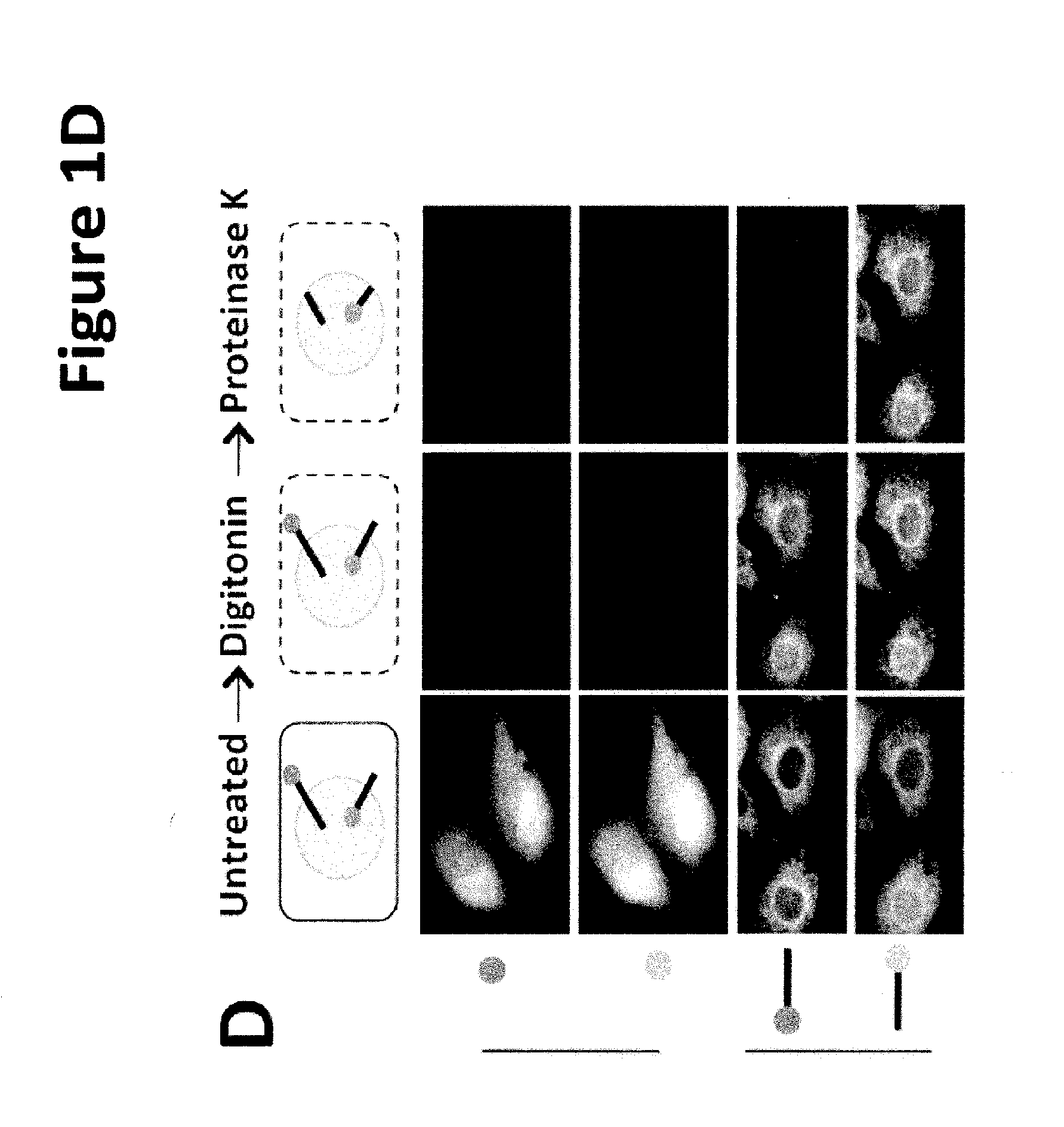Methods of diagnosis and treatment of endoplasmic reticulum (ER) stress-related conditions
a technology of endoplasmic reticulum and stress-related conditions, which is applied in the field of diagnosis and treatment of endoplasmic reticulum stress-related conditions, can solve the problems of cell death, many available therapies are dangerous, toxic, and sometimes ineffective, so as to improve or palliate the disease, delay or slow the progress of the disease, and reduce the extent of the disease
- Summary
- Abstract
- Description
- Claims
- Application Information
AI Technical Summary
Benefits of technology
Problems solved by technology
Method used
Image
Examples
example 1
PARP-16 is an Integral ER Membrane Protein
[0145]We previously identified a reticular membrane localization for uncharacterized PARP-16 in a screen analyzing PARP function using lypophilic dye DiI (FIG. 1A). To identify organelles to which it localizes, HeLa cells (utilized in all subsequent experiments) were stained with antibodies against PARP-16 and markers for membrane bound organelles—Calnexin, Lamin A / C, MTCO2, p230, and EEA1. Of these, PARP-16 and Calnexin localization strongly overlapped, suggesting that PARP-16 is an ER protein (FIG. 1A).
[0146]Based on primary sequence, PARP-16 is predicted to be a tail-anchored (TA) protein with a hydrophobic transmembrane domain at amino acid 288-308 (FIG. 1B; UniProtKB (Whitley et al., J. Biol. Chem. 271: 7583-7586, 1996)). TA proteins are single-spanning transmembrane proteins that contain cytoplasmic N-termini, short transmembrane domains (ΔC) and a PARP-16AA mutant failed to localize to the ER (a small portion of PARP-16AA remained ER ...
example 2
Characterization of PARP-16 Enzymatic Activity
[0147]To identify physiological functions of PARP-16, we analyzed phenotypes of PARP-16 knockdown and over-expression in HeLa cells. As we previously reported, at least two sets of siRNAs against PARP-16 caused a dramatic change in cell morphology, resulting in round cells (FIG. 2A). FACS analysis did not show an increase in the G2 / M DNA peak, suggesting that the phenotype is not a result of cell cycle defects. Instead, we observed a dramatic decrease in total ER as demonstrated by Calnexin staining (FIG. 2A). We further examined ER structure in the PARP-16 knockdown by examining intracellular membranes using lipophilic dye DiOC18 (FIG. 2B). In control knockdown cells, reticular and vesicular structures were observed in the cytoplasm. In contrast, in PARP-16 knockdown cells, the reticular structures were greatly reduced; instead, numerous puncta were observed. These results suggest that PARP-16 is required for the reticular organization ...
example 3
PARP-16 Enzymatic Activity is Important for the UPR
[0153]All known PARP-dependent stress responses result in up-regulation of PARP enzymatic activity (Hassa et al. Front. Biosci. 13: 3046-3082, 2008; Leung et al., Mol. Cell 42: 489-499, 2011). We examined PARP-16 enzymatic activity during the UPR via EMAA using cells expressing GFP-PARP-16 for 16 hours, a condition that did not affect ER organization (FIG. 2E). All subsequent EMAAs were performed in this manner. Cells expressing GFP-PARP-16 were treated + / −ER stress inducing agents, and PARP-16 activity assayed. ER stress resulted in significant increases in GFP-PARP-16 self-modification in a NAD+ dose-dependent manner (5-8 fold increase at 100 μM NAD+ and 8-13 fold increase at 200 μM NAD+, depending on stressor), and a dramatic electrophoretic mobility shift of GFP-PARP-16 was detected via immunoblot and autoradiogram (FIG. 6A). Additional higher molecular weight bands were also observed on the autoradiogram, migrating at the molec...
PUM
| Property | Measurement | Unit |
|---|---|---|
| Molar density | aaaaa | aaaaa |
| Pharmaceutically acceptable | aaaaa | aaaaa |
| Stress optical coefficient | aaaaa | aaaaa |
Abstract
Description
Claims
Application Information
 Login to View More
Login to View More - R&D
- Intellectual Property
- Life Sciences
- Materials
- Tech Scout
- Unparalleled Data Quality
- Higher Quality Content
- 60% Fewer Hallucinations
Browse by: Latest US Patents, China's latest patents, Technical Efficacy Thesaurus, Application Domain, Technology Topic, Popular Technical Reports.
© 2025 PatSnap. All rights reserved.Legal|Privacy policy|Modern Slavery Act Transparency Statement|Sitemap|About US| Contact US: help@patsnap.com



